SAMBASI TRABAJONO
January 27 to February 12 2024, Open studio, CDMX, Mexico

Installation view of «SAMBANO TRABAJOSI SAMBASI TRABAJONO», CDMX, January 2024.
All works depicted: Madeline Jimenez Santil.

Installation view of «SAMBANO TRABAJOSI SAMBASI TRABAJONO», CDMX, January 2024.
From left to right: Madeline Jimenez Santil, Sébastien Capouet.

Installation view of «SAMBANO TRABAJOSI SAMBASI TRABAJONO», CDMX, January 2024.
From left to right: Madeline Jimenez Santil, Sébastien Capouet, Benjamin Installé, Madeline Jimenez Santil, Sébastien Capouet.

Installation view of «SAMBANO TRABAJOSI SAMBASI TRABAJONO», CDMX, January 2024.
From left to right: Benjamin Installé, Sébastien Capouet.

Installation view of «SAMBANO TRABAJOSI SAMBASI TRABAJONO», CDMX, January 2024.
From left to right: Sébastien Capouet, Benjamin Installé, Sébastien Capouet.
Fables Paniques
April 22 to May 21 2023, Ada Ventura, Brussels

Installation view of «Fables Paniques», Ada Ventura, Brussels, April 2023.
From left to right: Victoria Palacios, Francesco Battistello, Benjamin Installé, Mathis Pettenati, Benjamin Installé

Installation view of «Fables Paniques», Ada Ventura, Brussels, April 2023.
From left to right: Victoria Palacios, Francesco Battistello, Benjamin Installé

Installation view of «Fables Paniques», Ada Ventura, Brussels, April 2023.
From left to right: Francesco Battistello, Benjamin Installé, Francesco Battistello, Mathis Pettenati, Benjamin Installé

Spaanse Nederlanden, 2023, cement sculpture and custom-made flight-case, total dimensions 67x47x158cm
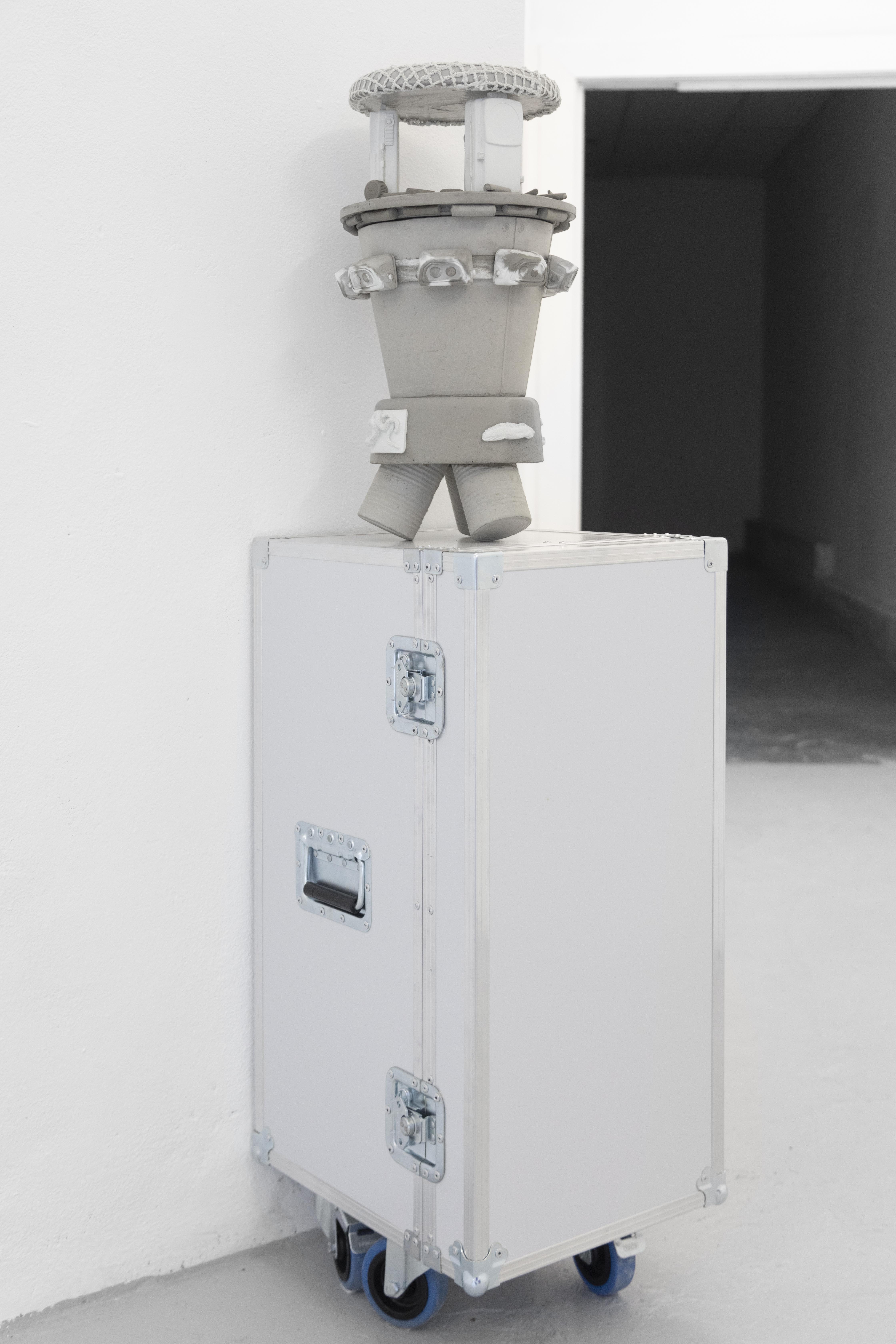
Angulas, 2023, cement sculpture and custom-made flight-case, total dimensions 35x42x142cm
Photos: Alice Pallot
Contes paniques is a collection of short stories written by Alexandro Jodorowsky in 1967. Inspired by this book, the exhibition Fables Paniques - curated by Florence Laprat - brings together the work of four artists: Francesco Battistello, Benjamin Installé, Victoria Palacios and Mathis Pettenati.
The exhibition presents visual parables that questions the absurdity of existence. We find the humour that characterises surrealism, the spiritual depth that Jodorowsky embodies and an irreverent theatricality. Between marginal anti-heroes, burlesque codes, costumes and folklore, the exhibition Fables Paniques brings together with derision and strangeness paintings and sculptures in a garage.
Zindering
February 18 to April 16, 2023, Emergent, Veurne
 Installation view of «Zindering», Emergent, Veurne, February 2023.
Installation view of «Zindering», Emergent, Veurne, February 2023.From left to right: Benjamin Installé, Victoria Palacios, Marcel Berlanger


From left to right: Benjamin Installé, Marcel Berlanger
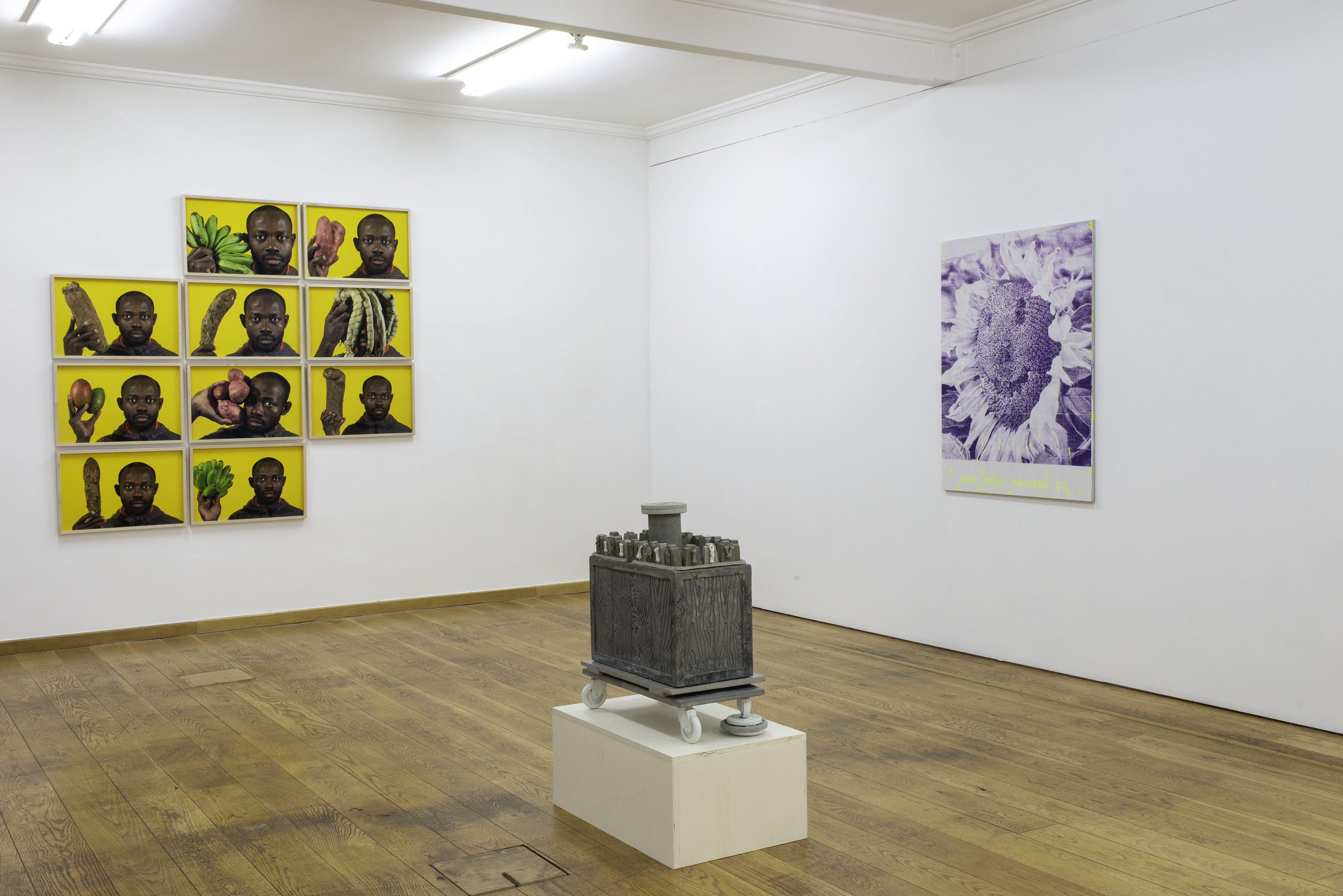
Installation view of «Zindering», Emergent, Veurne, February 2023.
From left to right: Guy Wouete, Benjamin Installé, Marcel Berlanger

Incensario, Cement and concrete, 56x32x65cm

Installation view of «Zindering», Emergent, Veurne, February 2023.
From left to right: Benjamin Installé, Victoria Palacios
 Installation view of «Zindering», Emergent, Veurne, February 2023.
Installation view of «Zindering», Emergent, Veurne, February 2023.
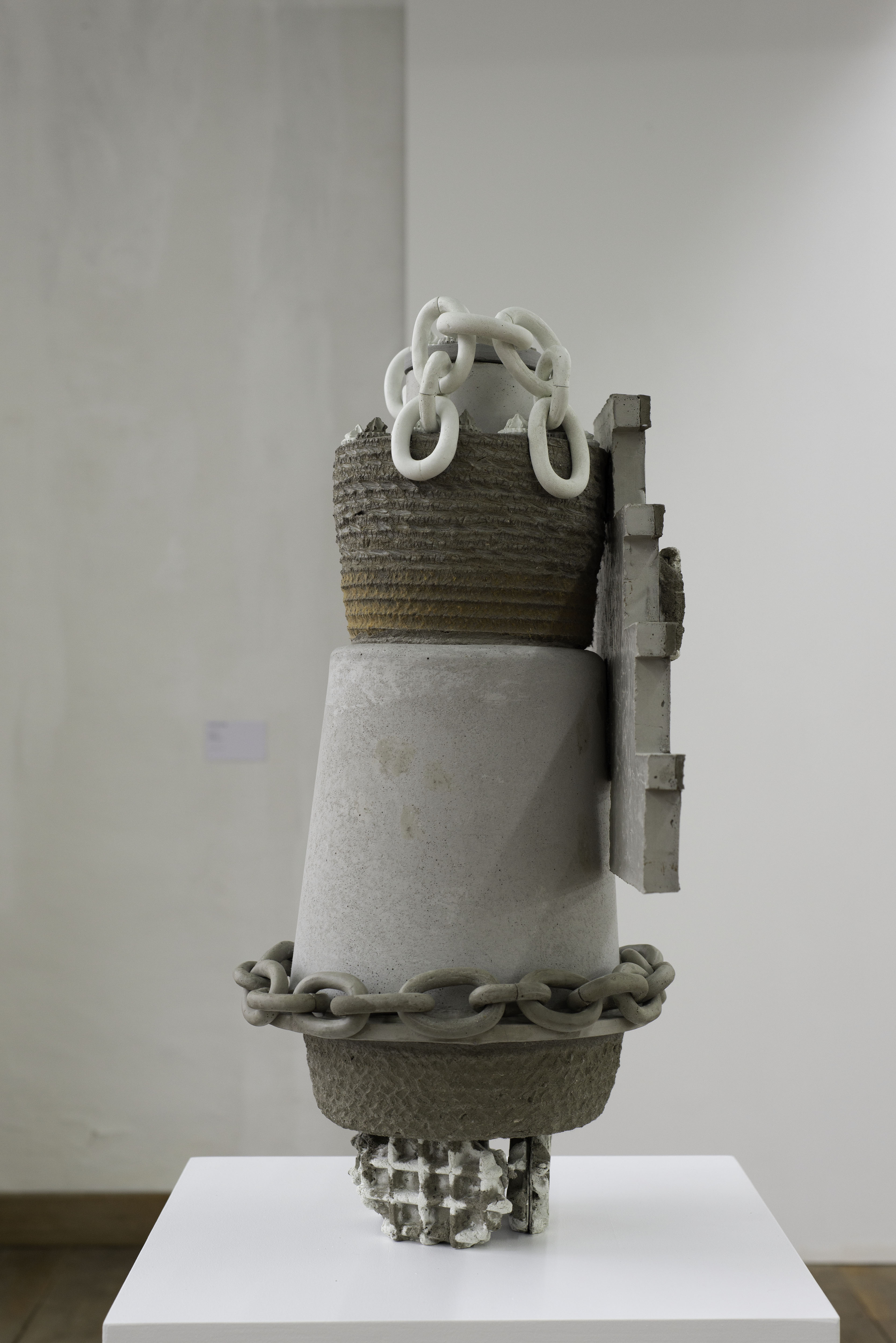
Spaanse Nederlanden, Cement, 65x32x73cm.
 Installation view of «Zindering», Emergent, Veurne, February 2023.
Installation view of «Zindering», Emergent, Veurne, February 2023.From left to right: Benjamin Installé, Victoria Palacios
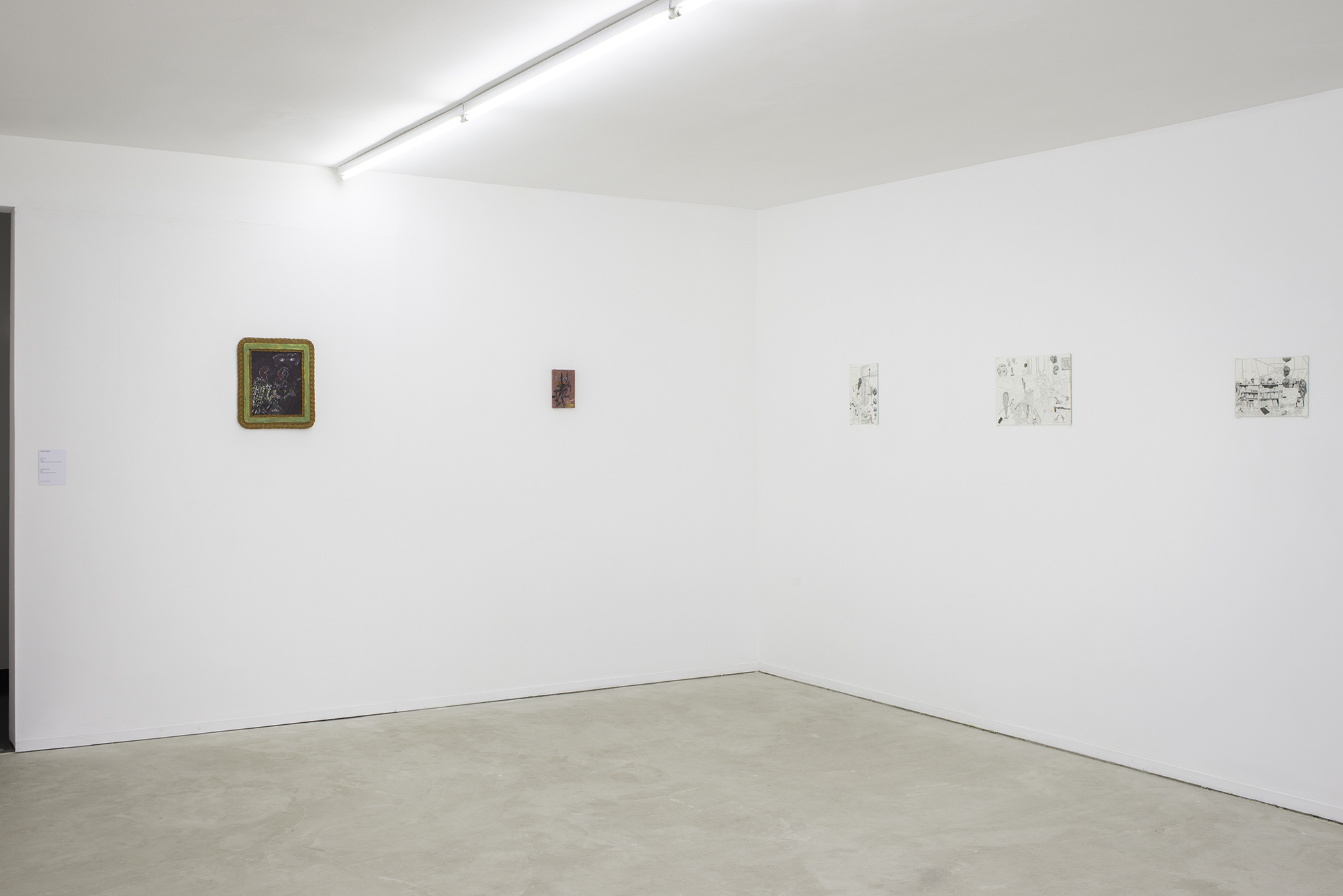
From left to right: Victoria Palacios, Benjamin Installé
Photos: Chantal Van Rijt
What do you do as an established artist when you have the opportunity to organize a major solo exhibition, while in these singular times so many young colleagues are struggling to find some visibility? Marcel Berlanger did not hesitate long about the answer: he decided to invite a group of artists he loved and admired - most of whom were considerably younger than himself - to exhibit together with him. There was no rigid theme imposed, no known guest curator: the artists simply got together and discussed their respective works. Because when it comes to art - as John Baldessari had already noted - the artists' gaze is absolutely unique: "Nobody looks at art like artists." For his selection of artists, Berlanger based himself on a few specific works in which he recognized common concerns or ways of working. Each artist refers, in his or her own way, and in a subtle manner, to our current time - a time that is, to say the least, peculiar, as it has been intertwined with an epidemic of COVID and a war in Ukraine that has led to a recession and to an energy crisis. While we are all living this turmoil first hand, artists are at the forefront.
With his imposing painting Imperium, Benjamin Installé evokes a reign in decline. The painting starts from the setting up - or rather the dismantling - of an exhibition, but the image makes us think at the same time of the collapse of an empire. Is it the West that is crumbling before our eyes? Victoria Palacios represents a colourful world of harlequins and circus acts. But underneath this gaiety lies a world full of anguish and mystery. The artist does not only use the classic canvas; she also paints on cheap materials such as bread, second-hand books and even "Crocs" clogs. Jan De Nys - the eldest of the group - works with found images and torn down posters to which he gives a new life, a new face. In a surreptitious way, he introduces the roughness of the street into the exhibition space, with a touch of rebellion. Guy Woueté often dwells in his art on labor and rebellion. He examines the alienation to which work can lead - as Marx denounced a century and a half ago - and sees similarities between the expansionism of multinational corporations and the exploitation of the colonial era.
If the work of the artists exhibited reflects - consciously or not - the time of the moment, it also goes further by its original formal language, its thematic choices and its aesthetic formulations. This is particularly true of Marcel Berlanger's paintings, which have something timeless but at the same time idiosyncratic about them, owing to their unconventional support: a fiberglass panel that creates a surprising spatial effect. The work was executed in an almost mechanical manner and the pictorial gesture was deliberately banished. But in these paintings of plants, sunflowers and polar ice caps, the climate in which we live in is again insinuated, almost carelessly, - while being transcended, as it should be in a polysemic art.
Sam Steverlynck
Closer
April 28 to May 29, 2022, Gevaert Editions, Brussels

Installation view of «Closer», Gevaert Éditions, Brussels, April 2022.

Installation view of «Closer», Gevaert Éditions, Brussels, April 2022.
 Installation view of «Closer», Gevaert Éditions, Brussels, April 2022.
Installation view of «Closer», Gevaert Éditions, Brussels, April 2022.Photos: Isabelle Arthuis
Closer featured a series of small framed ballpen drawings and linocut printed works on raisin paper.
The drawings were created in summer 2019 in a span of two weeks in my former apartment. They represented views of my home as seen from my bed, my couch or my kitchen table, populated by fantoms whose presence was made discernable by the hint of their scant actions such as drinking and smoking, reading, checking their phones or playing cards. I drew them as benevolent alter-egos that embodied what I aspired to back then: an ability to enjoy some kind of cheerful, nonchalant retirement.
The linocuts re-enacted years later these intimate drawings in a cathartic manner. Change of scale and medium implied new compositions, a different approach to expressivity with the use of carved lines and black color and a singular experience of self- estrangement percieved while carving patiently fresh images out of traces of a passed personal era.
Imperium
March 25 to April 25 2022, Le Botanique, Centre Culturel de la Communauté Française de Bruxelles, Brussels

Installation view of «Imperium», Le Botanique, Brussels, 2021.

Installation view of «Imperium», Le Botanique, Brussels, 2021.
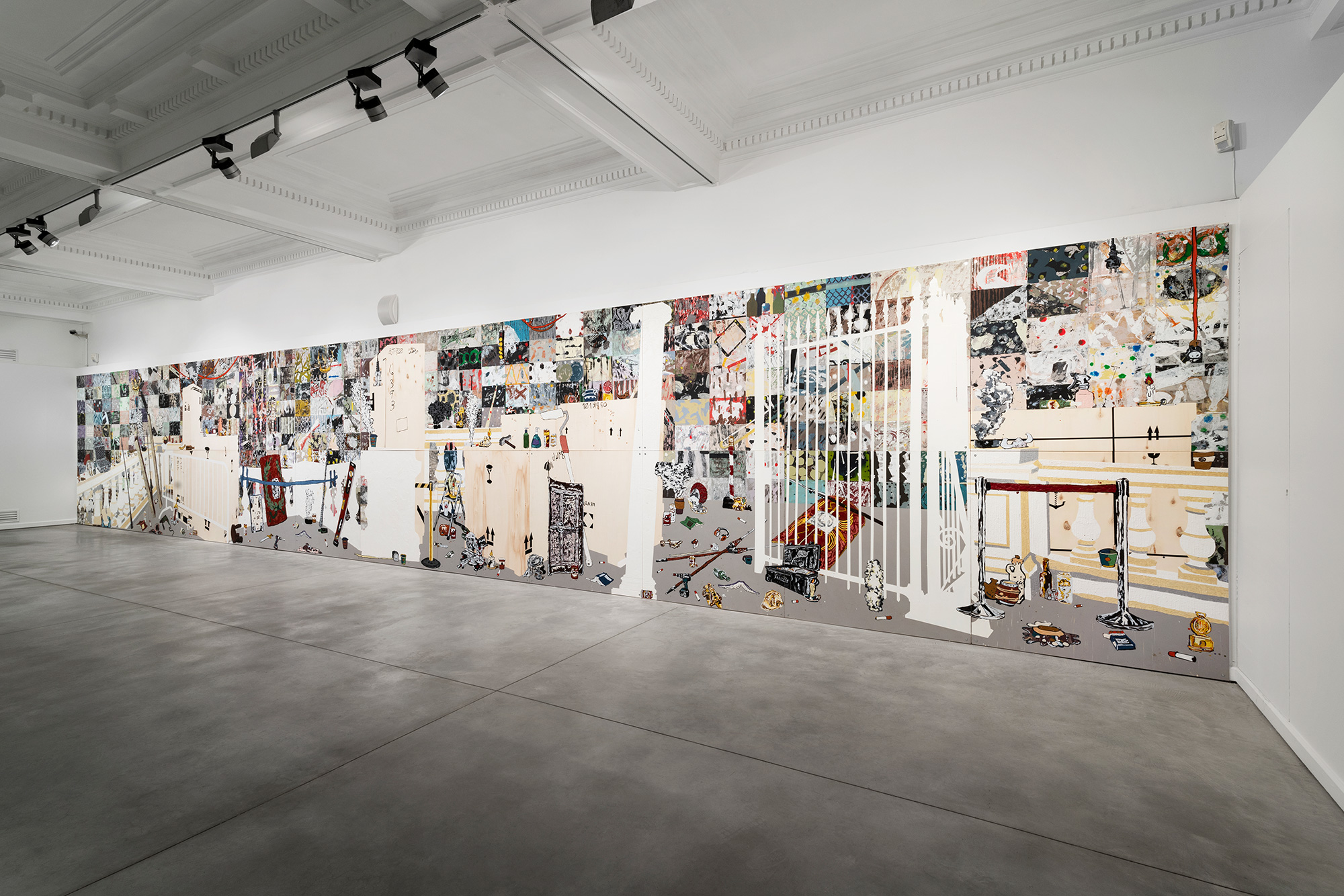
Installation view of «Imperium», Le Botanique, Brussels, 2021.
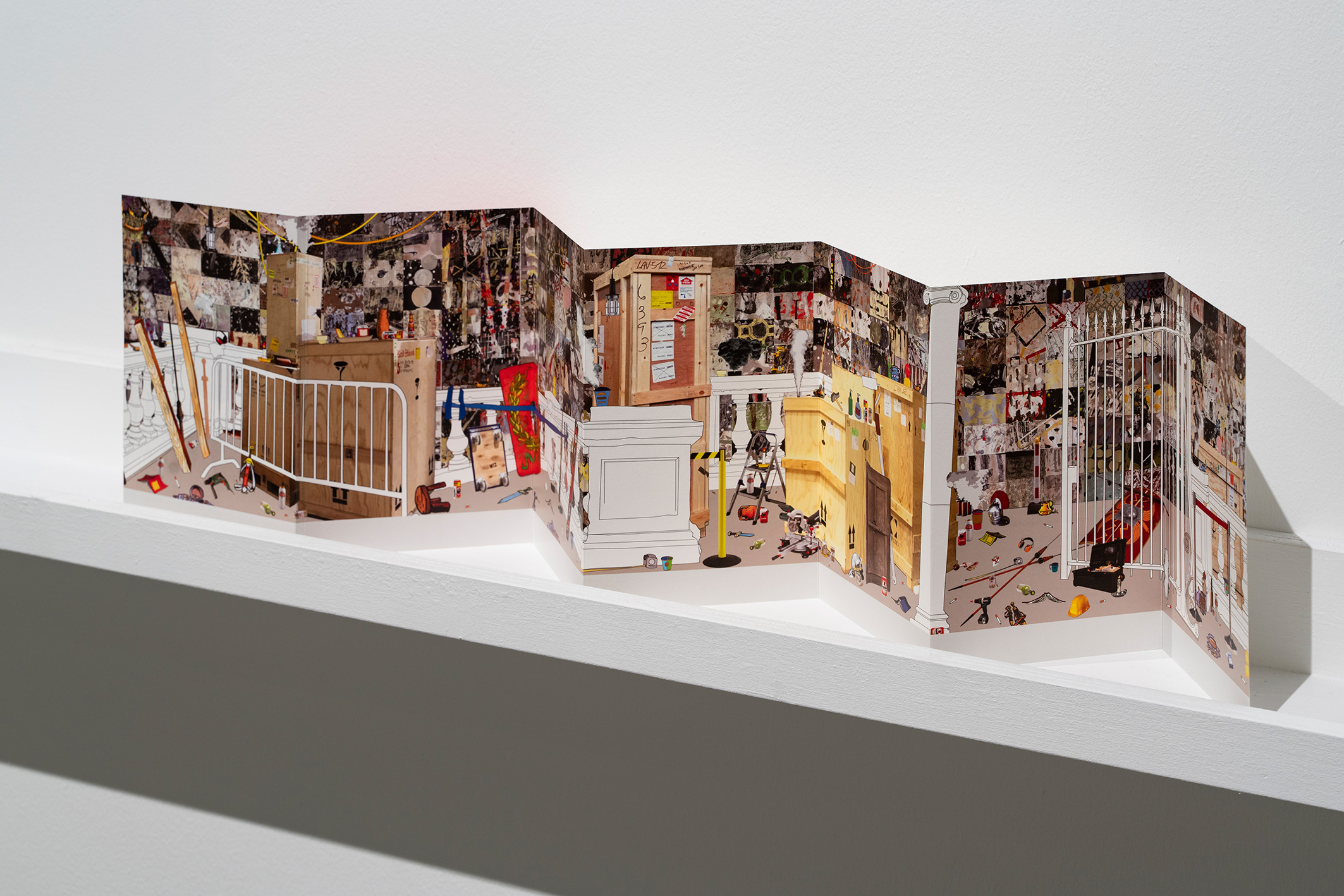
Installation view from «Imperium», Le Botanique, Brussels, March 2021.

Photos: Fabrice Schneider
This solo exhibition presented a large-scale site-specific painting and an artist publication conceived as a visitor’s guide.
The painting represented a quite undefined, neither interior or exterior space which could have been all together a construction site, the building-up of an exhibition or a theatrical decor hastily deserted by its protagonists at the end of the representation due to a sudden disaster or because of general hangover.
Influenced by Spinozian concept of «Imperium» pursued in an eponymous essay by philosopher and researcher Frédéric Lordon, the aim of this pictural project was to materialise in visible form hidden collective forces of passion laying out a specific societal situation, i.e an art institution under constant renovation, located in a city area daily crossed by precarious, anonymous workers.
Providência
April 21 to May 27 2018, BPS22, Musée d’art de la Province de Hainaut
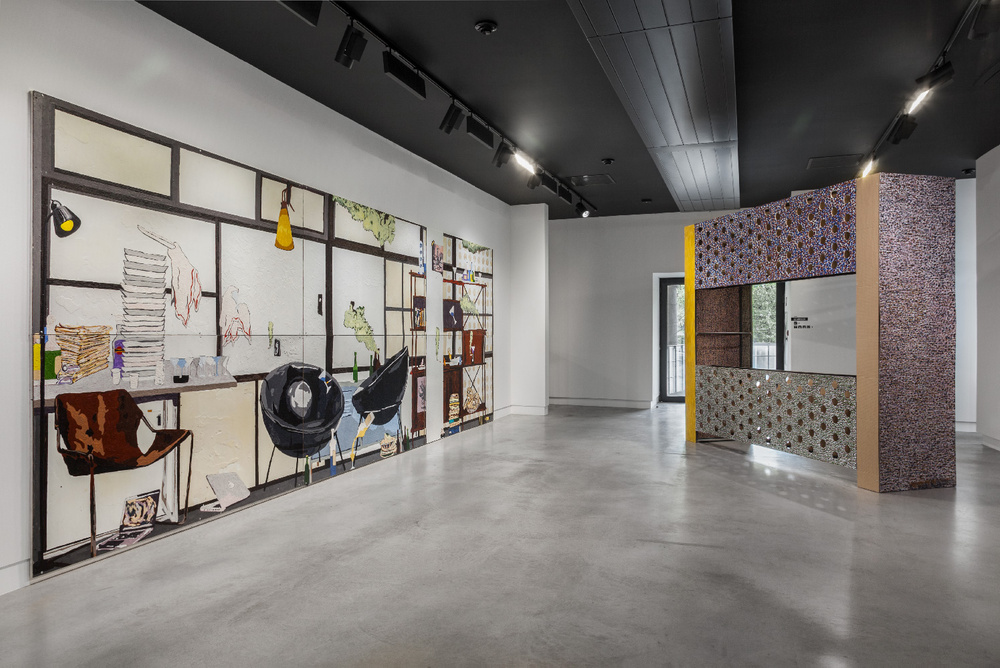 Installation view of “Providência”, BPS22, 2018
Installation view of “Providência”, BPS22, 2018
April 21 to May 27 2018, BPS22, Musée d’art de la Province de Hainaut
 Installation view of “Providência”, BPS22, 2018
Installation view of “Providência”, BPS22, 2018
Installation view of “Providência”, BPS22, 2018
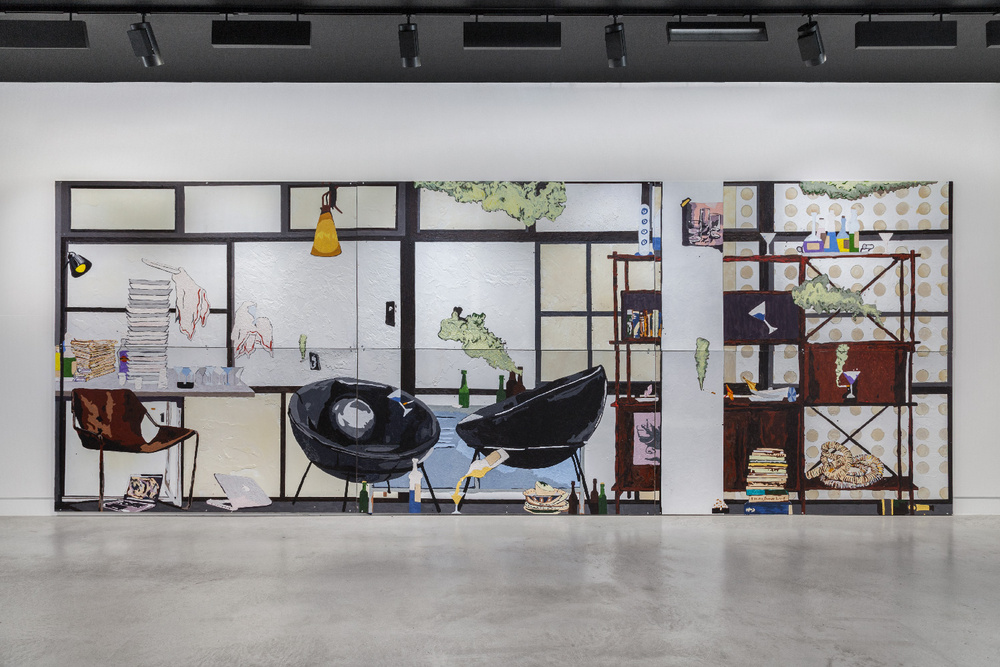
Installation view of “Providência”, BPS22, 2018
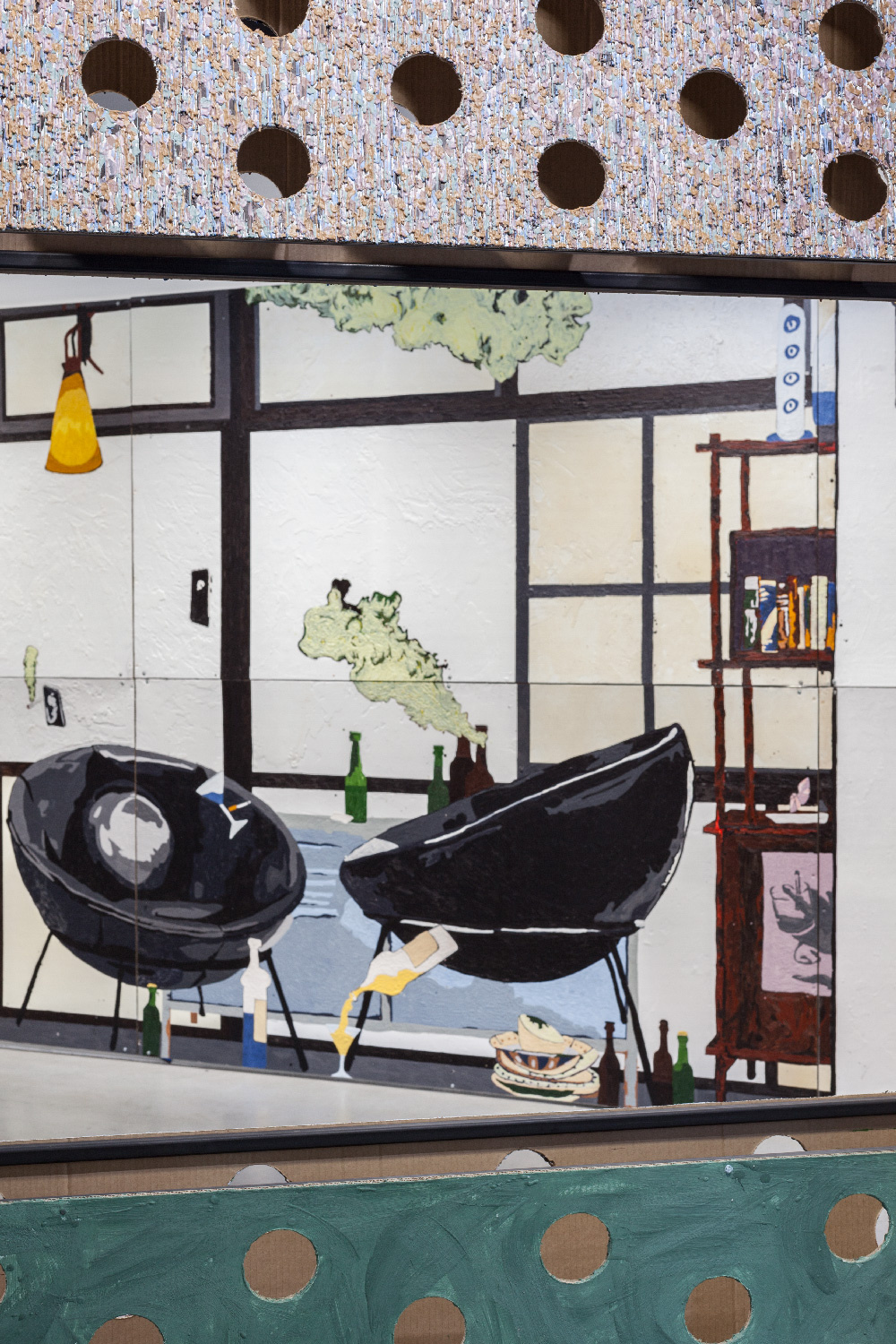
Installation view of “Providência”, BPS22, 2018
Photos: Fabrice SchneiderOn the occasion of a trip to Sao Paulo, Brazil, I met simultaneously the brilliant oeuvre of modernist Brazilian architect Oscar Niemeyer and the city’s jaunty art world, two years after the adminitrative putsch against Dilma Rousseff’s administration and a few months before Jair Bolsonaro’s election.
Out of this double encounter, I conceived the show as both a tribute to the architect’s work and a rendition of the peculiar social group I found myself immersed in for a short time. In this sense, I re-interpreted two of the architect’s buildings I daily frequented: the California building where I had my studio, and the Eiffelbuilding where I was generously hosted.
First artwork was a large painting scaled to the bay window of the Eiffel flat I lived in. It represented a clear, transparent interior room in which fantoms smoke, chat, read or danse, in a general atmosphere of idleness and stagnation. Objects are depicted moving by themselves in the air, inspired by the first filmic experiences of Hans Richter (Ghost Before Breakfast) and by Jasper Johns’s paintings from the eighties (Racing Thoughts).
Second artwork was constructed as a full scale model of the California balcony, turning it into a sculptural object studying elementary formal principles of sculpture, painting and architecture in a modernist spirit, by affixing painted cardboard panels onto a steel structure.
Chorus of Cold People
November 24 2017, Swallowing Helmets, Brussels
 Installation view of “Chorus of Cold People”, Swallowing Helmets, 2017
Installation view of “Chorus of Cold People”, Swallowing Helmets, 2017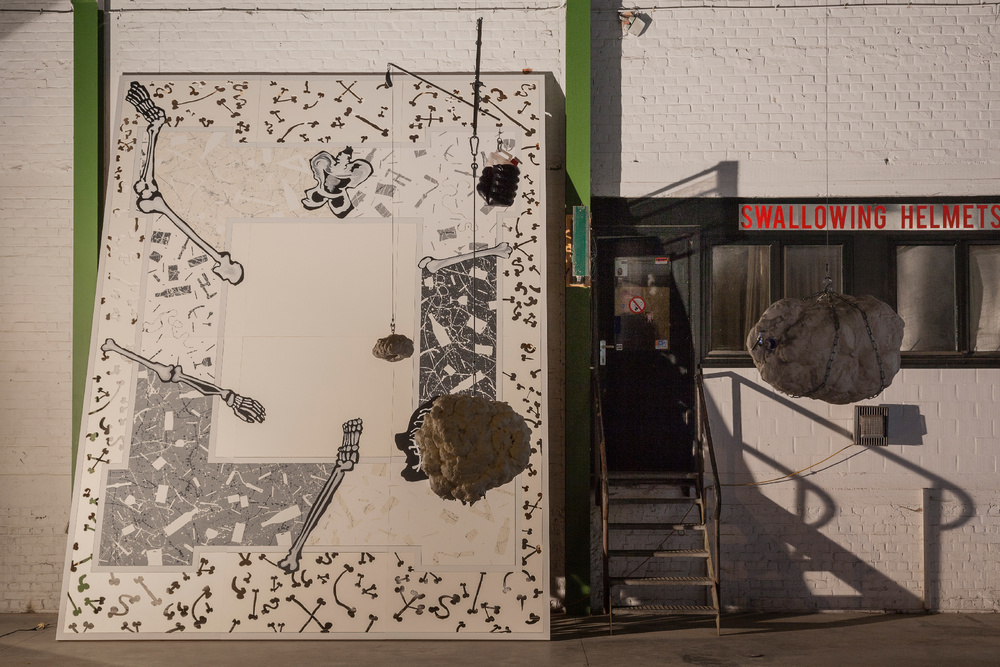 Left: Benjamin Installé, Chorus of Cold People, Acrylic on wood panels, 2017, 360x 480cm
Left: Benjamin Installé, Chorus of Cold People, Acrylic on wood panels, 2017, 360x 480cmRight: Stéphanie Quirola
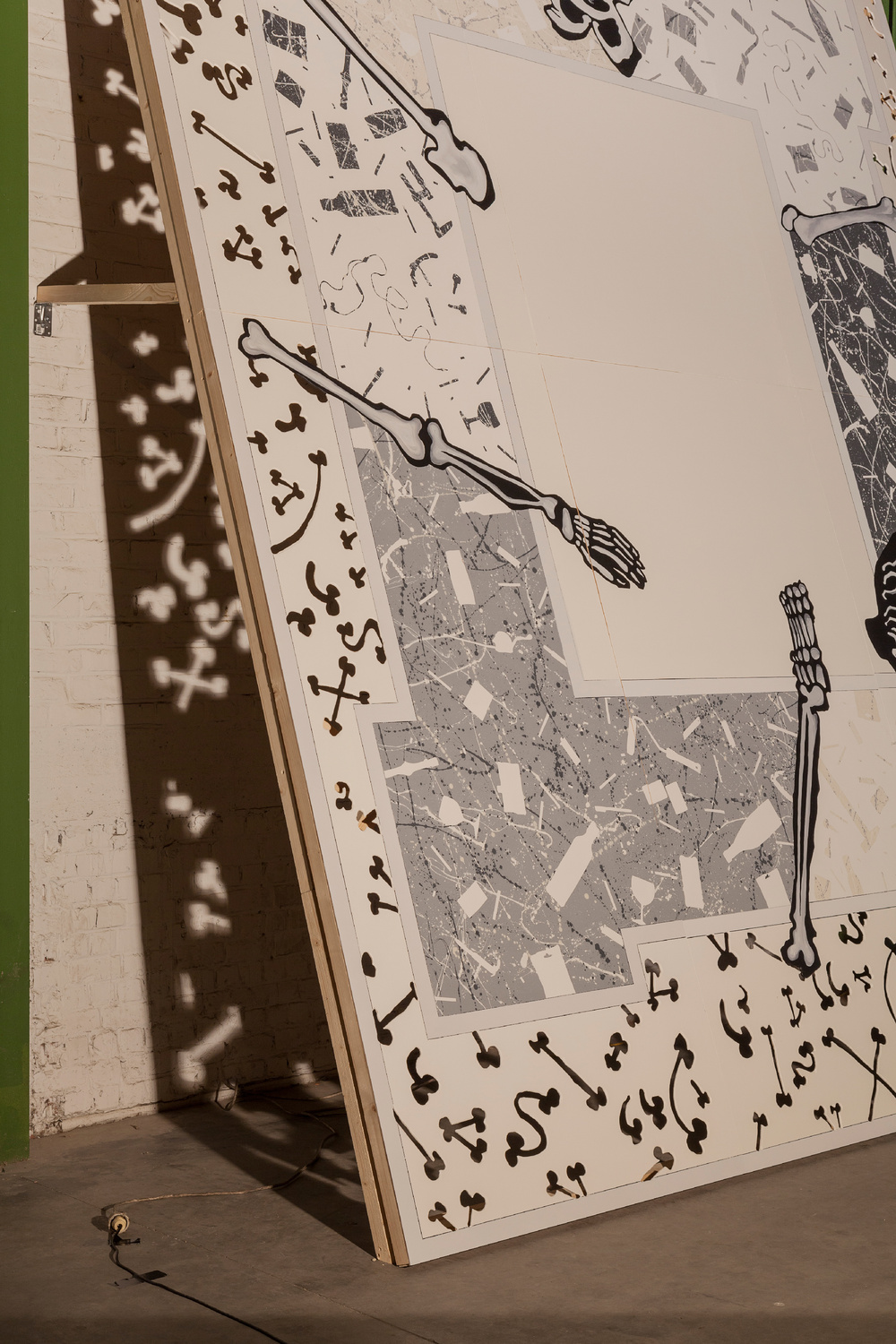
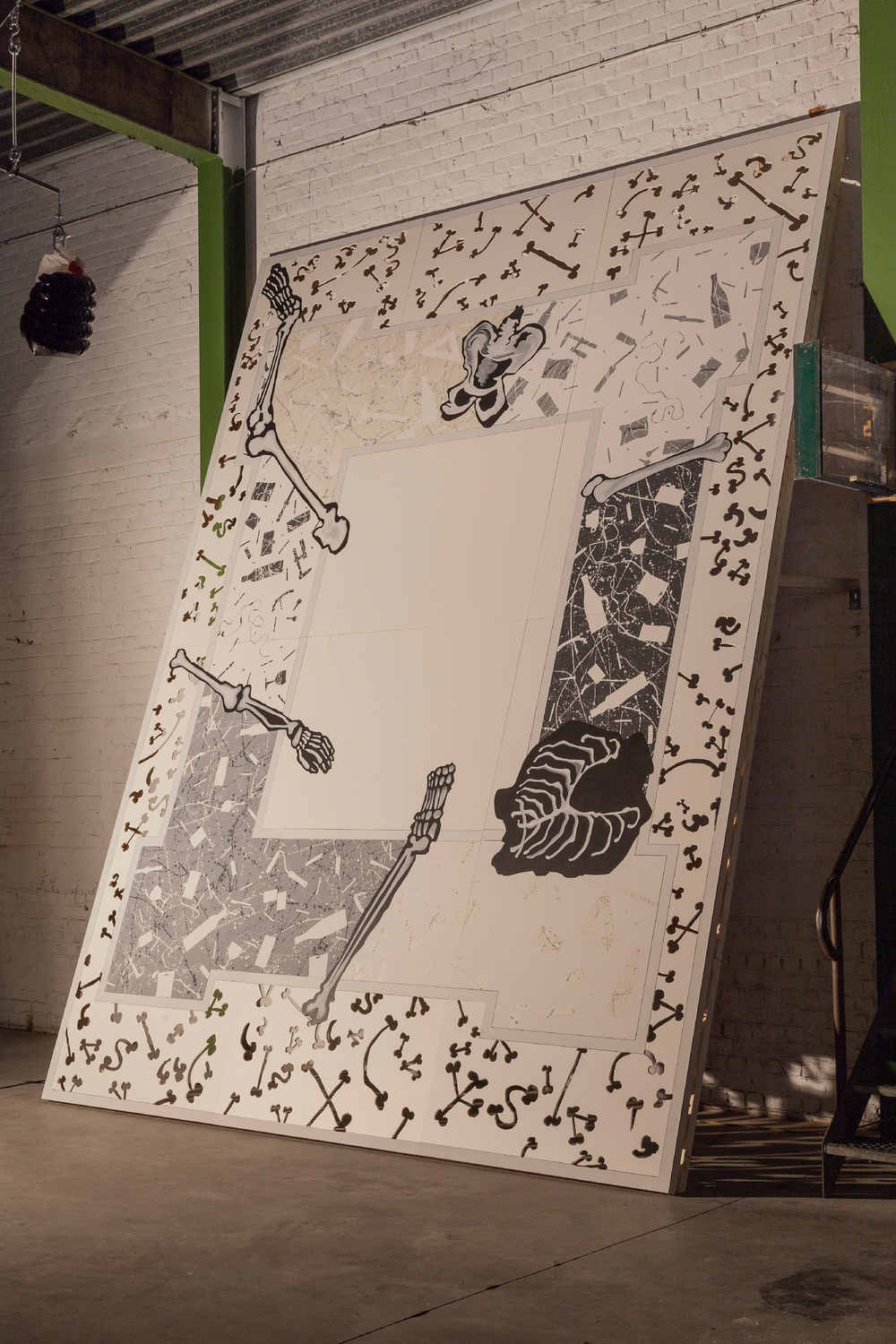
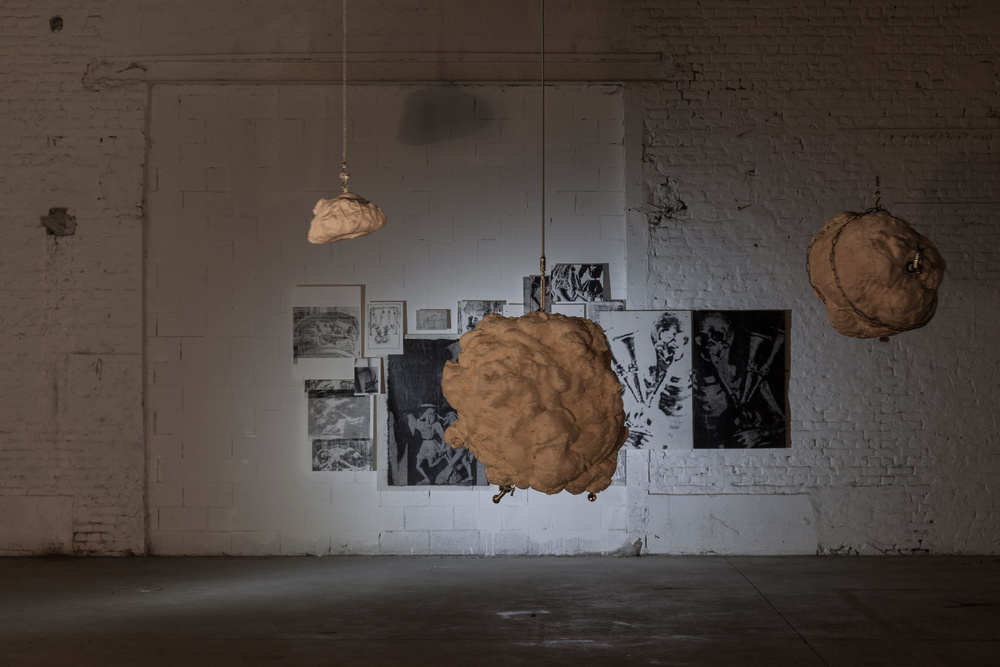 Front: Stéphanie Quirola
Front: Stéphanie QuirolaBackwards: Maxime Le Bon
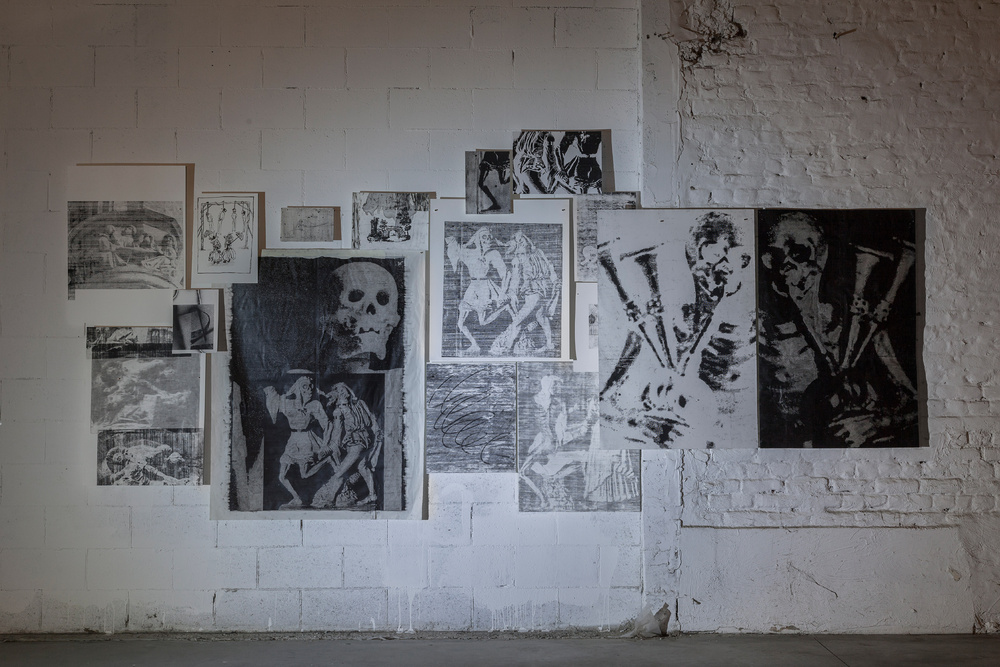 Maxime Le Bon
Maxime Le Bon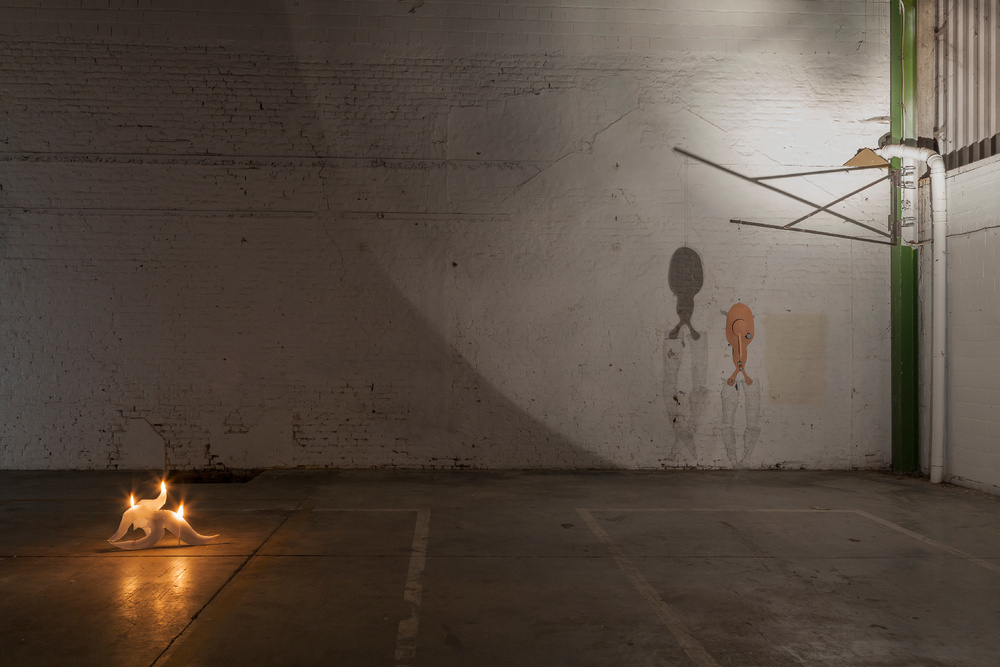 Left: Nicholas Goudket. Right: Cyriaque Villemaux
Left: Nicholas Goudket. Right: Cyriaque Villemaux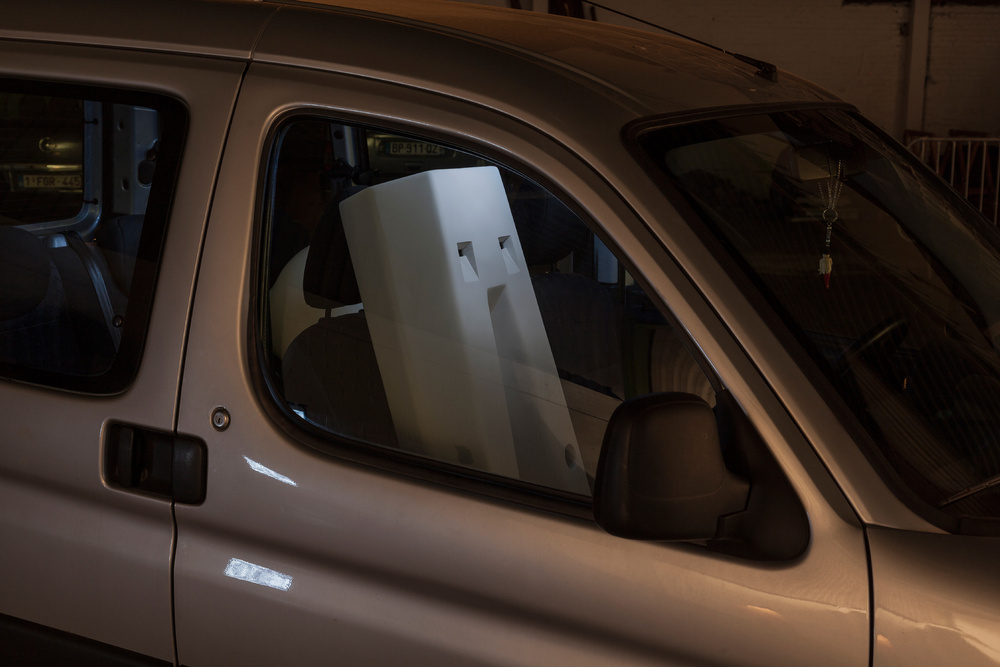 Gaillard & Claude
Gaillard & Claude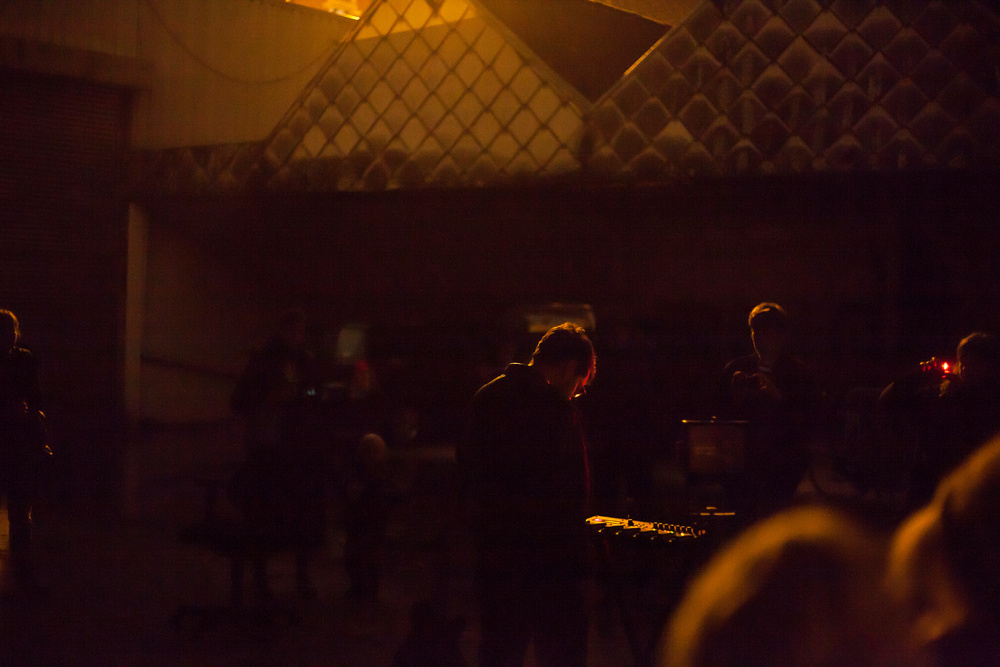 Juan Pablo Plazas
Juan Pablo Plazas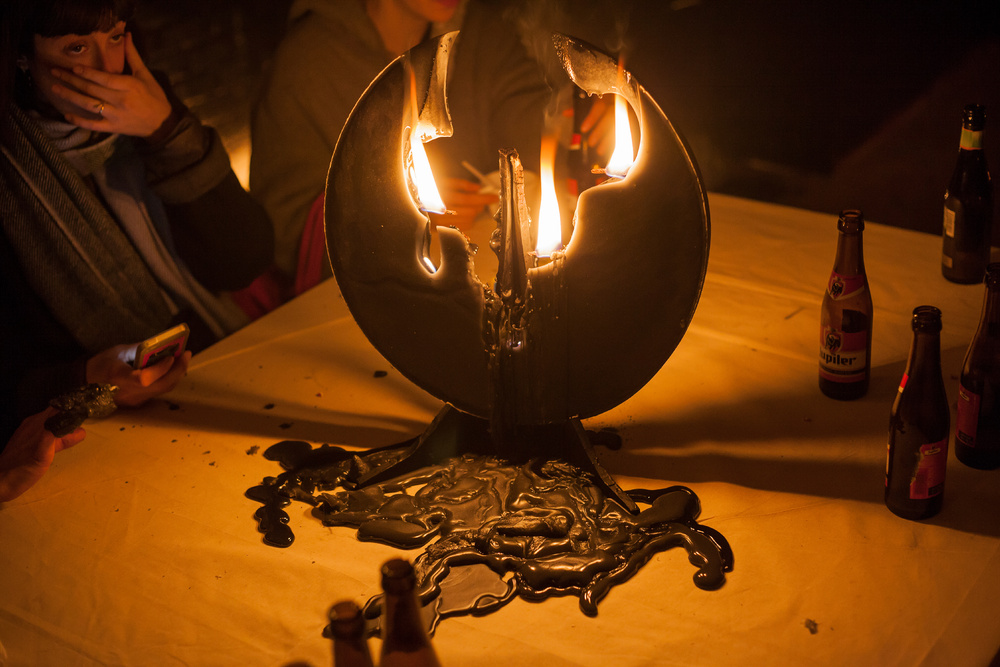 Nicholas Goudket
Nicholas Goudket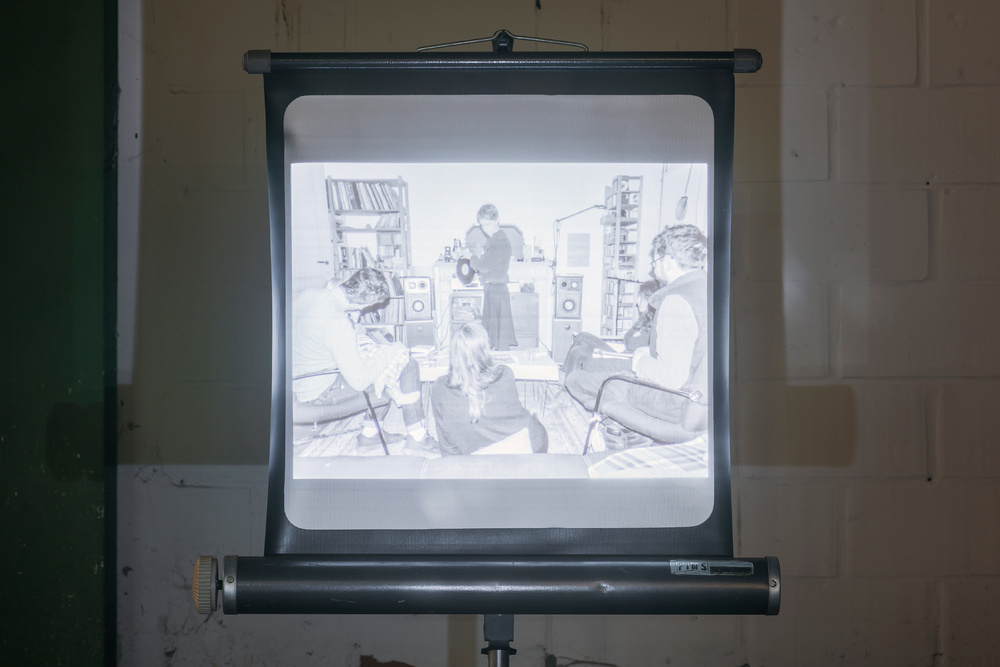 Danielle Brognon, Hélène Clerc-Denizot, Olivia Degrez, Sylvie Eyberg, Rameau Geronnez, Benjamin Installé, Diego Thielemans
Danielle Brognon, Hélène Clerc-Denizot, Olivia Degrez, Sylvie Eyberg, Rameau Geronnez, Benjamin Installé, Diego ThielemansPhotos: Fabrice Schneider
Chorus of Cold People was a one-evening exhibition I organized together with collective Swallowing Helmets, inspired by romantic music and symbolist litterature.
With Gaillard&Claude, Nicholas Goudket, Benjamin Installé, Maxime Le Bon, Juan Pablo Plazas, Stephanie Quirola, Cyriaque Villemaux, Danielle Brognon, Hélène Clerc-Denizot, Olivia Degrez, Sylvie Eyberg, Rameau Geronnez, Diego Thielemans
With Gaillard&Claude, Nicholas Goudket, Benjamin Installé, Maxime Le Bon, Juan Pablo Plazas, Stephanie Quirola, Cyriaque Villemaux, Danielle Brognon, Hélène Clerc-Denizot, Olivia Degrez, Sylvie Eyberg, Rameau Geronnez, Diego Thielemans
Tiger Juice
April 23 to May 20 2017, Cissiste International, Brussels. Duo show with Valérie Mannaerts.
 Front: Valérie Mannaerts.
Front: Valérie Mannaerts.Back: Gorgone, steel structure, painted wooden volumes, 2017, approx. 80x210x80cm
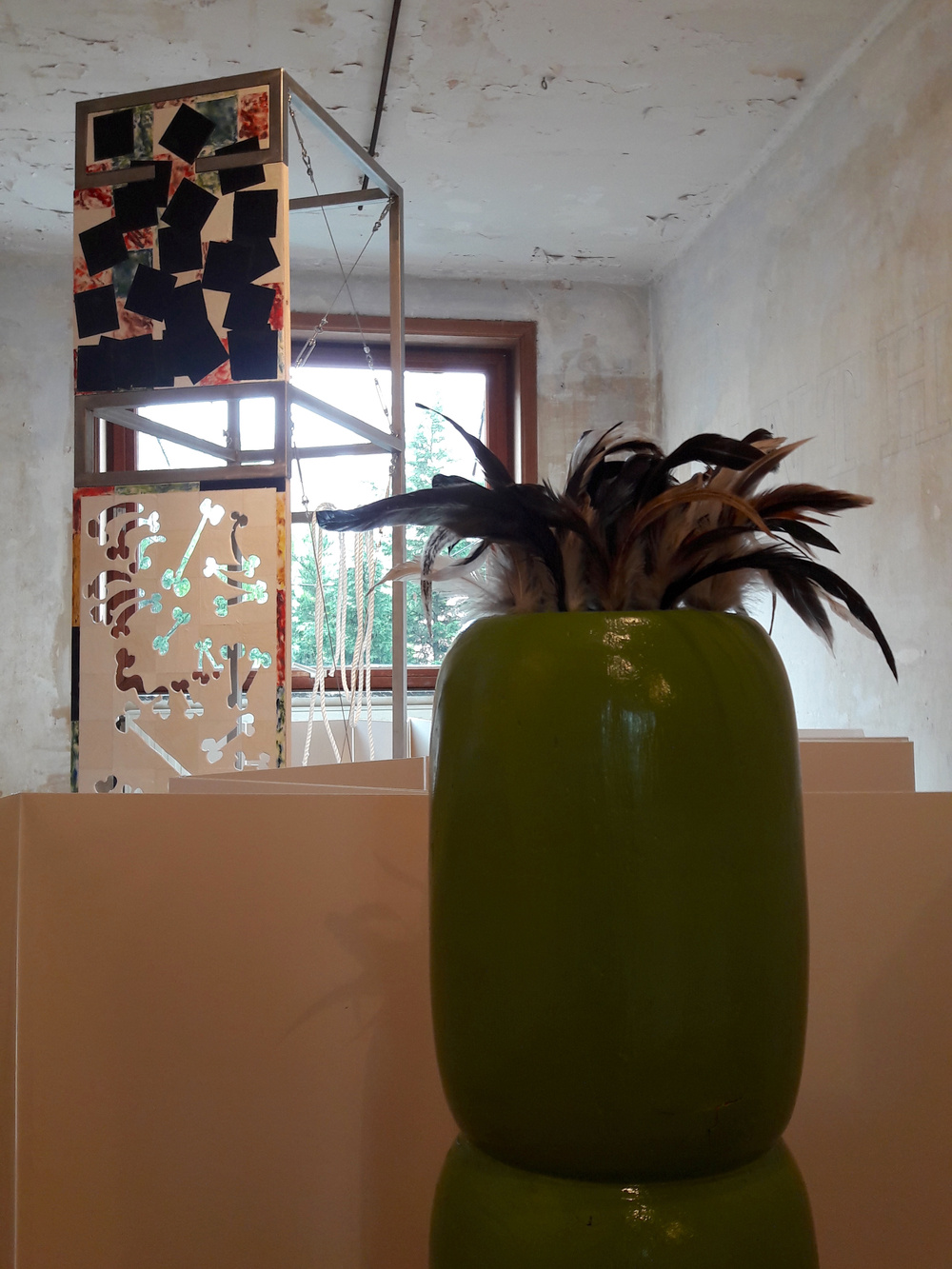
Front: Valérie Mannaerts.
Back: Totem, steel structure and painted wooden panels, 2017, approx. 60x220x90cm

Front: Valérie Mannaerts.
Back: Tank, steel structure, painted wooden volumes, 2017, approx. 50x200x80cm
This duo exhibition with artist Valérie Mannaerts happened in an artist’s studio. I realized for the occasion three standing sculptures that displayed painted volumes. The sculptures were made of stainless steel and incorporated metaphorical operations for studio practice such as pressure, tension, inclusion, connection. The painted volumes fitted into the steel structures and were painted using various techniques on every facet, mostly inspired by French romantic painter Eugène Delacroix’s representations of lions and tiger.
Sgraffito
May 14 to May 22 2016, WIELS Project Room, Brussels
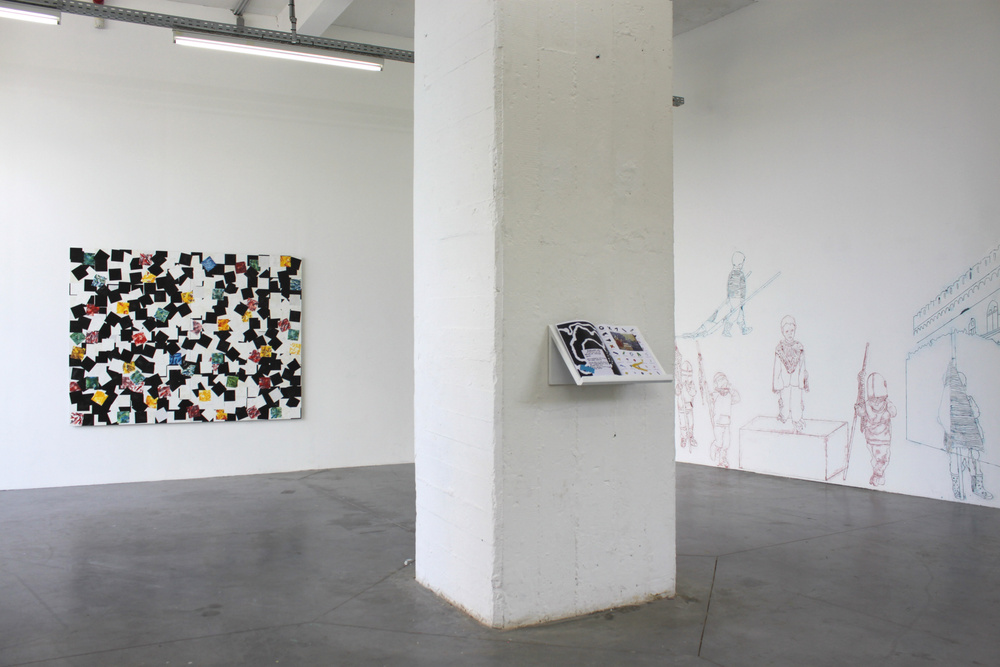 Installation view of “Sgraffito”, WIELS Project Room, 20
Installation view of “Sgraffito”, WIELS Project Room, 20
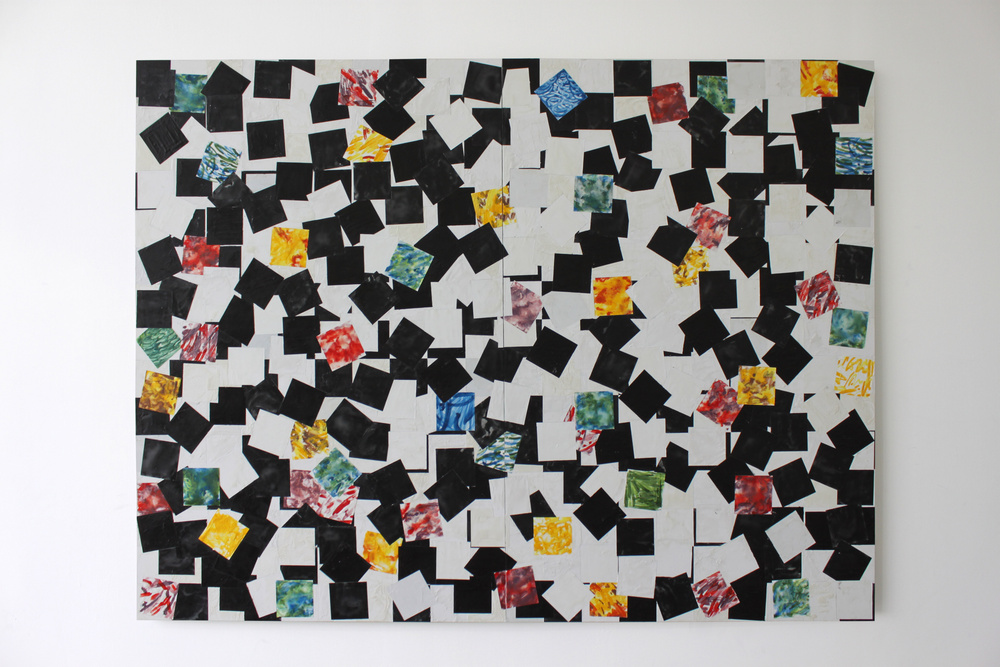 Sgraffisti, 2016, beeswax on paper mounted on aluminium panels, dyptich, 150x200cm
Sgraffisti, 2016, beeswax on paper mounted on aluminium panels, dyptich, 150x200cm
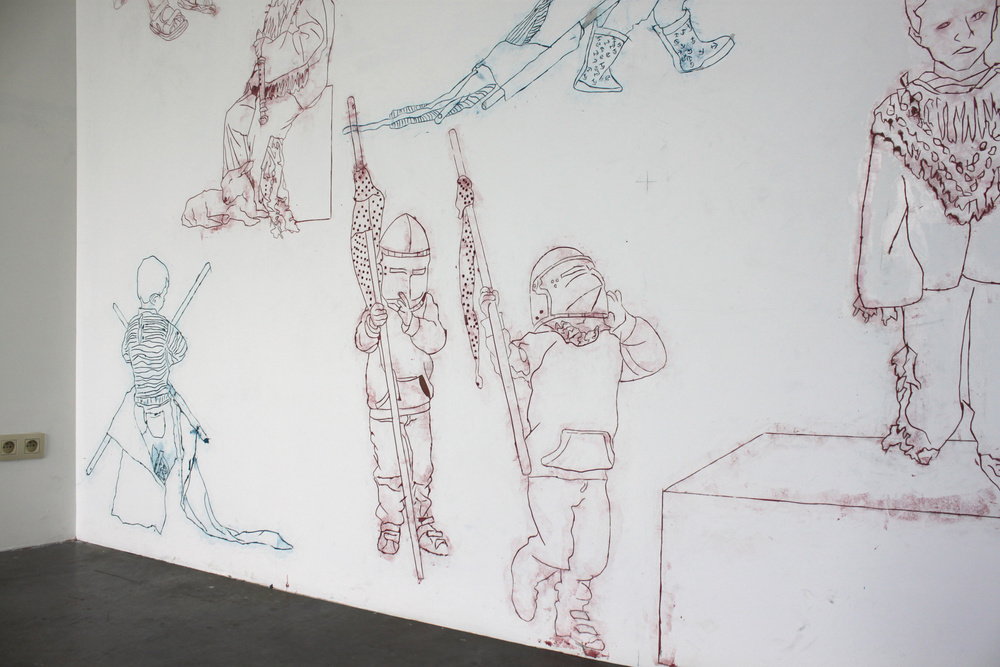 La Croisade des Enfants, 2016, engraved wall and colored sand, various dimensions
La Croisade des Enfants, 2016, engraved wall and colored sand, various dimensions
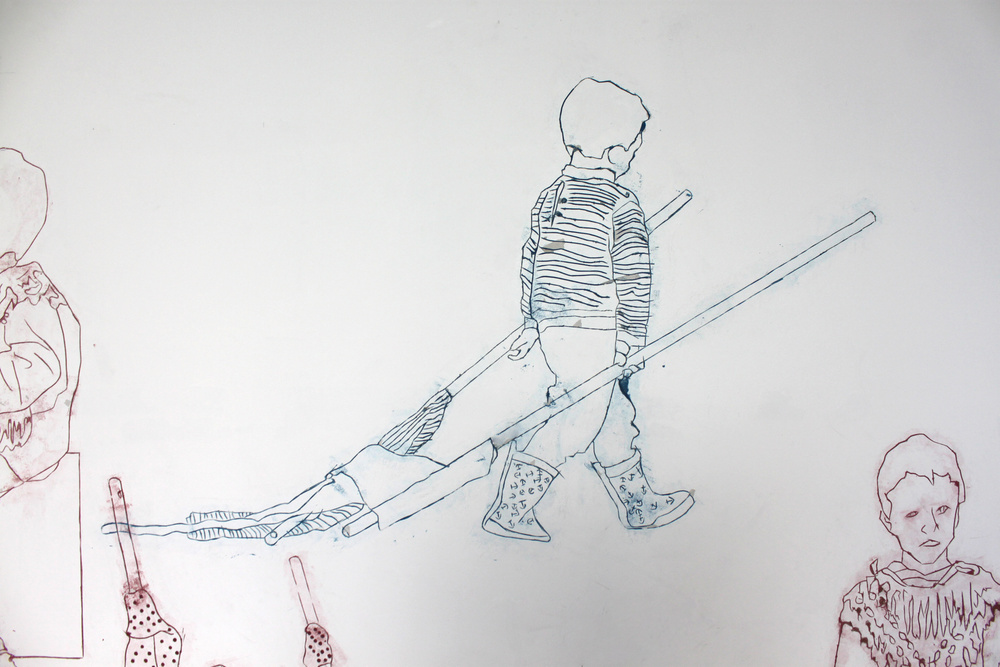
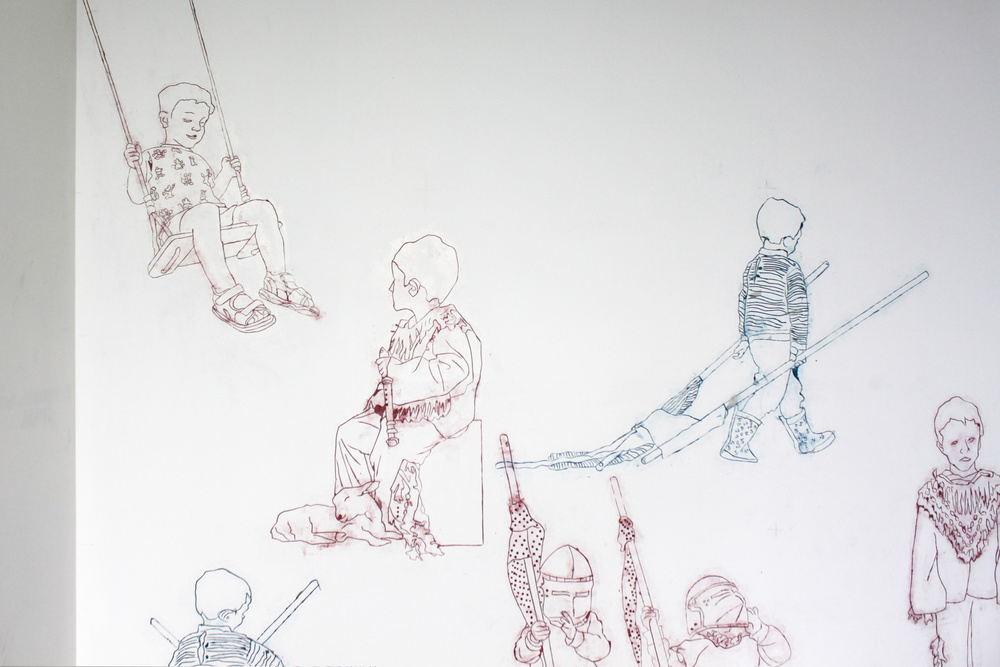
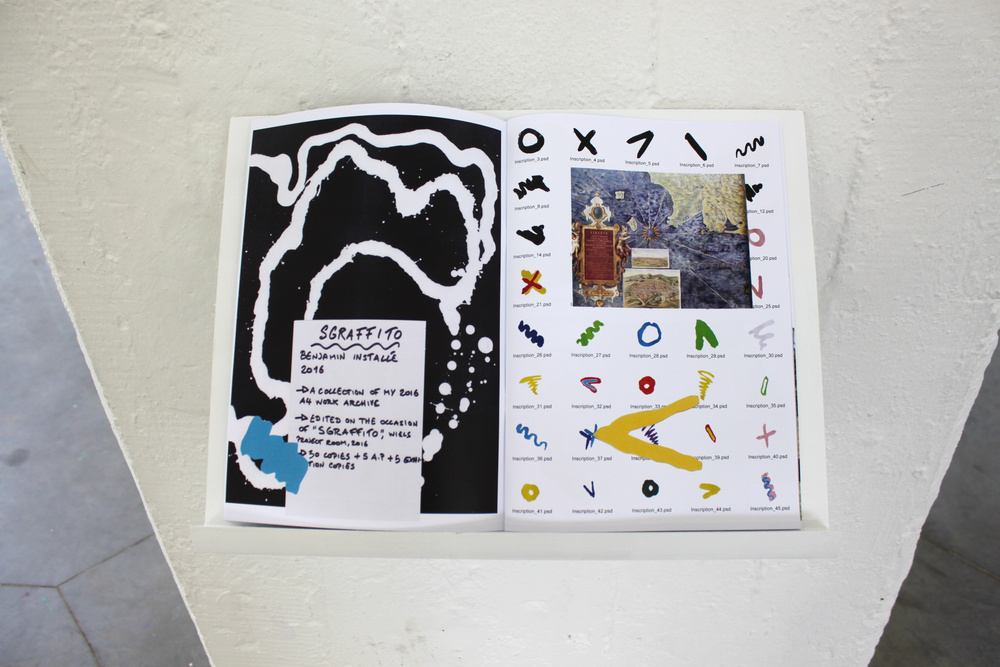 Sgraffito, artist publication, 30 copies + 5a.p + 5 exhibition copies
Sgraffito, artist publication, 30 copies + 5a.p + 5 exhibition copies
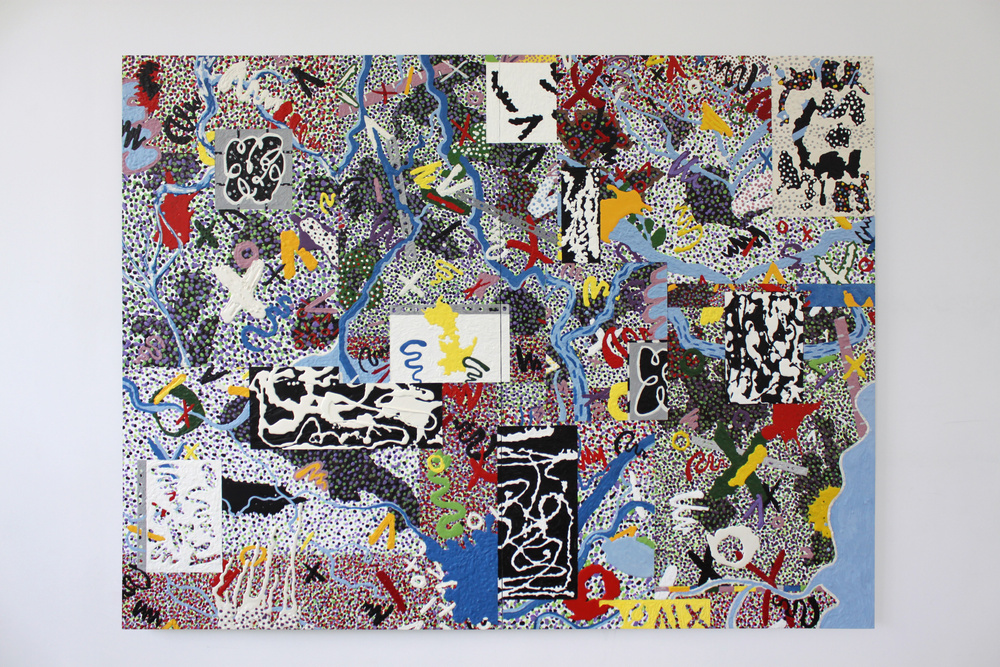
Map or Spring in my Step, 2016, beeswax on paper mounted on aluminium panels, dyptich, 200x150cm
"Now, Lord, hear the quivering whispers which rise from this little cell in my basilica, and counsel me. My servants, from the countries of Flanders and Germany even to the towns of Marseille and Genoa, have brought me strange news. Women naked and speechless have been seen running through the cities. These shameless mutes were pointing to the sky. More than one madman has preached ruin in the public squares. The hermits and the wandering clerks are full of rumours. And I know not by what spell more than seven thousand children have been drawn from their homes. Seven thousand are on the roads with cross and staff. They have nothing eat ; they have no arms ; they are helpless and a shame to us. They are ignorant of all true religion. My servants questioned them. They answered that they were going to Jerusalem to conquer the Holy Land. My servants told them that they could not cross the sea. They answered that the sea would part and dry up to let them pass. Good parents, godly ones and wise, try to keep them back. They break their bolts by night and climb the walls. Many are sons of nobles and of courtizanes. It is very pitiful. Lord, all these innocents will be given over to shipwreck […]."
– Marcel Schwob, The Children’s Crusade (trans. Henry Copley Greene), 1905.
Back: Tank, steel structure, painted wooden volumes, 2017, approx. 50x200x80cm
This duo exhibition with artist Valérie Mannaerts happened in an artist’s studio. I realized for the occasion three standing sculptures that displayed painted volumes. The sculptures were made of stainless steel and incorporated metaphorical operations for studio practice such as pressure, tension, inclusion, connection. The painted volumes fitted into the steel structures and were painted using various techniques on every facet, mostly inspired by French romantic painter Eugène Delacroix’s representations of lions and tiger.
Sgraffito
May 14 to May 22 2016, WIELS Project Room, Brussels
 Installation view of “Sgraffito”, WIELS Project Room, 20
Installation view of “Sgraffito”, WIELS Project Room, 20 Sgraffisti, 2016, beeswax on paper mounted on aluminium panels, dyptich, 150x200cm
Sgraffisti, 2016, beeswax on paper mounted on aluminium panels, dyptich, 150x200cm La Croisade des Enfants, 2016, engraved wall and colored sand, various dimensions
La Croisade des Enfants, 2016, engraved wall and colored sand, various dimensions


Map or Spring in my Step, 2016, beeswax on paper mounted on aluminium panels, dyptich, 200x150cm
"Now, Lord, hear the quivering whispers which rise from this little cell in my basilica, and counsel me. My servants, from the countries of Flanders and Germany even to the towns of Marseille and Genoa, have brought me strange news. Women naked and speechless have been seen running through the cities. These shameless mutes were pointing to the sky. More than one madman has preached ruin in the public squares. The hermits and the wandering clerks are full of rumours. And I know not by what spell more than seven thousand children have been drawn from their homes. Seven thousand are on the roads with cross and staff. They have nothing eat ; they have no arms ; they are helpless and a shame to us. They are ignorant of all true religion. My servants questioned them. They answered that they were going to Jerusalem to conquer the Holy Land. My servants told them that they could not cross the sea. They answered that the sea would part and dry up to let them pass. Good parents, godly ones and wise, try to keep them back. They break their bolts by night and climb the walls. Many are sons of nobles and of courtizanes. It is very pitiful. Lord, all these innocents will be given over to shipwreck […]."
– Marcel Schwob, The Children’s Crusade (trans. Henry Copley Greene), 1905.